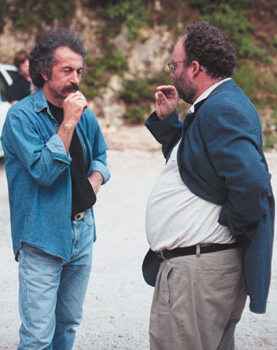Arcane complication or vital property? Opinions about particle spin differ, but those who feel strongly about it say that more spin has to come into collision.

The problem with proton spin is that it does not add up. A recent workshop, which was held at the European Centre for Theoretical Studies (ECT) in Trento, Italy, brought together 34 leading theorists and experimentalists from 12 countries to discuss the theoretical and experimental status of the “proton-spin problem”, to identify the key quantities and to formulate a strategy for measuring them.
Particular emphasis was given to comparing the contributions expected from new polarized (spin-oriented) scattering experiments at CERN, DESY (Hamburg) and SLAC (Stanford), polarized proton-proton collisions at Brookhaven’s new Relativistic Heavy-Ion Collider (RHIC), an electron-ion collider (EIC), also at Brookhaven and a possible new polarized HERA electron-proton collider at DESY.
For polarized HERA, the spin of the existing proton beam would be made directional. Looking further ahead, the THERA scheme plans to use electrons from the TESLA superconducting electron-positron linacs and polarized protons in HERA.<textbreak=Missing spin>Polarized scattering experiments at CERN, DESY and SLAC in which the incident beams probe deep inside the target particles suggest that only about 20-30% of the proton’s spin is carried by the intrinsic spin of its quark and antiquark constituents – less than half the prediction of quark models. Where is the spin coming from? This mystery has inspired vast theoretical and experimental activity to analyse and understand the spin structure of the proton.
The present status of experimental data from fixed-target experiments was reviewed by Alessandra Fantoni (Frascati and HERMES) and Fabienne Kunne (Saclay and SMC/COMPASS). Detailed presentations also covered polarized deep-inelastic measurements at small parton momentum x (x is the fractional momentum of the quark; Barbara Badelek, Uppsala), hard exclusive processes (Moskov Amarian, NIKHEF) and nuclear effects (Valeria Muccifora, Frascati). Albert De Roeck (CERN) and Naohito Saito (RIKEN-Brookhaven) reviewed the new physics possibilities at polarized electron-proton colliders (HERA, THERA and EIC) and at polarized proton-proton collisions at RHIC.
The spin decomposition of the proton was discussed in the opening talk by Robert Jaffe (MIT), who underlined the theoretical subtleties in the definition and measurability of quark orbital angular momentum and the physics prospects for measuring spin from transversely polarized targets.

The prospects for measuring the spin-flavour structure of the proton were discussed by Jechiel Lichenstadt (Tel Aviv), Giovanni Ridolfi (Genova) and Gaby Rädel (Palaiseau), who emphasized that tightly confined sprays (“jets”) of particles from quark-antiquark pairs deep inside high-energy, polarized electron-proton collisions provide a “gold-plated” measurement of gluon polarization in the proton. This mechanism is not dependent on theoretical interpretation.
Steven Bass (Trento) stressed the possible connection between the spin structure of the proton and the long range gluon dynamics that are responsible for the unaccountably large mass of the h´ meson (the famous “U(1) problem” of quantum chromodynamics). These ideas could be tested through elastic neutrino-proton scattering, which provides complementary information about the spin structure of the proton. Rex Tayloe (Indiana) reported on an exciting possibility for a definitive neutrino-proton elastic experiment using the miniBooNE set up at Fermilab.
Polarized electron-proton colliders could map out the spin-dependent structure function, g1, down to x of about 10-4, providing powerful new constraints on small x physics in addition to decisive measurements of gluon polarization in the proton. Pointing out complementary studies, Anthony Thomas (Adelaide) emphasized that polarized deep-inelastic scattering at large x (almost unity) is a sensitive probe of the valence quark structure of the nucleon. Precision measurements of the large-x region are planned at Jefferson Laboratory.
Sum rule status
In polarized photoproduction, the present status of tests of the Drell-Hearn-Gerasimov (DHG) sum rule was reported by Klaus Helbing (Erlangen) and Zein-Eddine Meziani (Temple). The DHG sum rule relates spin dependent total cross-sections to the anomalous magnetic moment of the proton target and is derived from fundamental principles. Any violation of this sum rule would challenge our present understanding of spin in QCD.
The theory and status of spin transfer reactions, in which the spin of both the target and the outgoing particle is measured, was discussed by Jacques Soffer (Marseille). The potential of polarized colliders to probe new physics was reviewed by Jean-Marc Virey (Provence). Contributions were made on developments in QCD parton phenomenology, transverse polarization observables, single-spin asymmetries and exclusive channels, and this motivated a great deal of discussion about the physics potential of future experiments to unravel the spin structure of the proton.

The workshop ended with a presentation and comparison of the physics prospects of polarized electron-proton collider projects – polarized HERA (Albert De Roeck, CERN) and the electron-ion collider (EIC; Abahy Deshpande, RIKEN-Brookhaven and Witek Krasny, Paris), which are currently under discussion respectively at DESY and, particularly, at Brookhaven. A workshop on the EIC project is scheduled for March 2002 at Brookhaven. Possible future fixed-target programmes were also discussed by Wolf-Dieter Nowak (DESY Zeuthen).
Polarized proton-proton and electron-proton colliders are potentially a very useful tool for the investigation of the spin and chiral structure of any new physics beyond the minimal electroweak Standard Model that might be revealed with the corresponding unpolarized colliders. Building on the programme of polarized proton-proton collisions currently under way at RHIC in the US, it is worthwhile to investigate the physics potential of future polarized proton-proton collisions in CERN’s LHC. The workshop revealed considerable enthusiasm within the spin community for possible future developments with the LHC.





